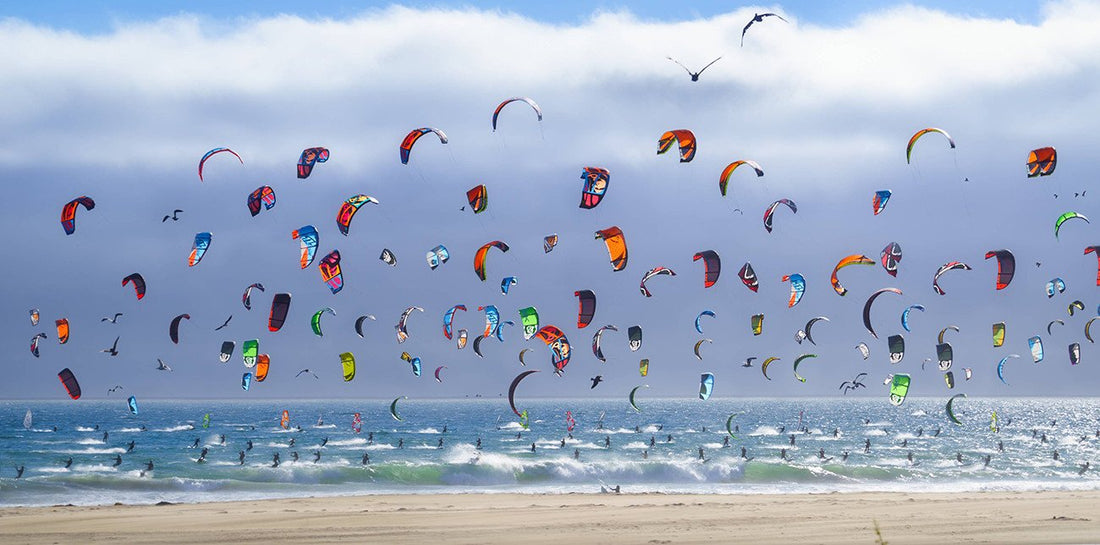
How to Choose a Kiteboarding Kite?
Share
How to Choose the Proper Size Kiteboarding Kite
You've always wanted to become a kiteboarder ever since you saw the first guy kitesurfing at the beach. After months of procrastination, you finally decide to take the plunge. No excuse is going to keep you from enjoying the freedom and thrill kiteboarding brings. However, like cycling, this sport is best learned by doing rather than watching how to videos and reading tons of books. To get started you need some starter lessons and the most important piece of gear; your kitesurfing kite. There are many reputable organizations that will teach you how to ride the kite so that won't be covered here. What's covered is the kite itself and what considerations you need to make when selecting the right size for first time kitesurfing.
How to choose the right size kiteboarding kite
You're at a point where every pro and amateur kitesurfer must go through. It's more or less a rite of passage where you get to choose the kite that will help you glide through the air as adrenaline surges through your body - or the kite that will force you out of the sport. This guide will enable you choose the former type to ensure that your first kitesurf experience will be one of the best you'll ever have. But before looking at the important considerations to make when selecting the right kitesurfing kite size, let me explain why size is so important.
A kite that's too small will not take off no matter how strong the winds are and if it does, you won't remain in the air too long. A kiteboarding kite that's too large on the other hand will take off easily. However, handling will be difficult and dangerous even in slow winds.
With that said, here are the most important considerations to make when choosing the proper size of your first kite.
Know the different sizes available
Knowing the different sizes on the market will be your first step to knowing which suits your needs best. The size is described in meters. Although most people might think it's the length of the kite, this measurement indicates the total surface area in square meters. The sizes available today range between 5 meters to over 18 meters. The size goes a long way in determining how easy and comfortable your ride will be when you consider the next factors.
Your body weight
For a kiteboarding kite to take off, the force placed on the kite by wind should be large enough to be able to lift your body weight. You'll also have to consider factors such as friction between the kiteboard and the water surface that cause resistance (which will be discussed later) Your body weight should therefore be one of the important factors to consider when determining what size of kite to choose. The following are rough estimates matching body weight and the recommended kite size:
- 120 pounds or less = 5 meters
- up to 150 pounds = 7 meters
- up to 175 pounds = 9 meters
- up to 200 pounds = 11 meters
- over 200 pounds = 13 meters and above
It's worth noting that this is a mere estimate. It's recommended that you do some research about the wind speeds in your preferred kiteboarding spot as this also plays a crucial role in determining whether the kite you buy will lift off.
Your kiteboard
Other than your kite, your kiteboard is another important piece of kiteboarding gear. It allows you to glide over the water's surface while you pick up speed before take off. The board design plays a huge role in determining how much force is needed to eventually take off. Small boards have more drag and require more force to eventually take off. A larger kite is therefore needed. Larger boards on the other hand have less drag meaning a small kite will be just enough for take off.
Wind speeds
The body weight to kite size table above assumes that the kitesurfing location has average wind speeds of 15 to 25 miles per hour. If only things were so simple. Some spots have average wind speeds lower than 12mph while others have wind speeds well above 25mph. So before you grab a kite and head out kiteboarding, you'll need to know what average wind speeds are prevailing. For wind speeds below 15mph, it's advisable to get a kite that's up to 3 meters larger than what's indicated on the table. Invest in kites that are up to 3 meters smaller than what's indicated in the table if the wind speeds in your kiteboarding location are above average. Of course it helps to consult with local kitesurfers to get an idea about the wind speeds and the sizes they would recommend for your particular spot.
Riding season
Closely related to the prevailing wind speeds is the seasons. Season largely affects the prevailing wind conditions. A slight change in weather can mean an increase or decrease in wind speeds. It's therefore important that you consider which seasons you would prefer to go kitesurfing. After this, research the wind patterns that prevail during these seasons. This will give you an idea about the kite size you should invest in.
Kitesurfing in the future
If your first kitesurf experience goes well, it's very unlikely that you'll hang up your kite and call it quits. You'll want more action and challenge. That's where kitesurfing in the future comes in. You'll want to invest in a kite that will last a couple of seasons before you invest in another one. If you intend to kiteboard during different seasons and in different wind speeds, you might want to invest in one or two other kites of different sizes.
If you intend to become part of the rapidly growing sport of kiteboarding, you'll have to invest in the right sized kite. They come in different sizes each designed for particular wind speeds, kiteboarder weight and kitesurfing style. Finding the right size is important if you want your kite to act as an ally as you battle with the wind and glide above open waters. This guide has covered the most important considerations to make when choosing the right sized kite. Hopefully, you're now in a position to check out the different brands on the market and begin your journey into the world of kitesurfers.
